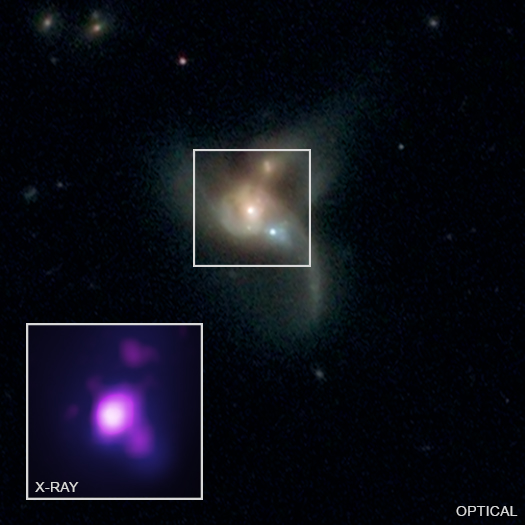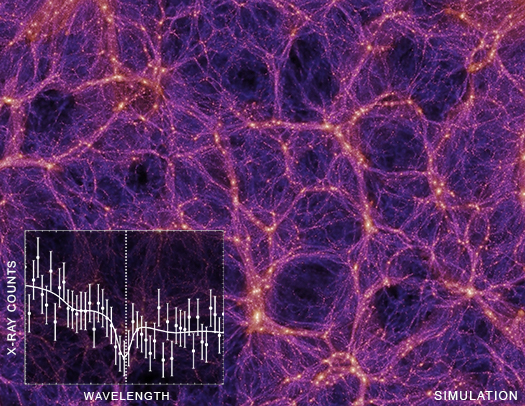Quasars & Active Galaxies
A Weakened Black Hole Allows Its Galaxy to Awaken
The Phoenix galaxy cluster contains the first confirmed supermassive black hole that is unable to prevent large numbers of stars from forming in the core of the galaxy cluster where it resides. This result, reported in our latest press release, was made by combining data from NASA's Chandra X-ray Observatory and Hubble Space Telescope, and the NSF's Karl Jansky Very Large Array (VLA). A new composite image shows data from each telescope. X-rays from Chandra depict hot gas in purple and radio emission from the VLA features jets in red. Optical light data from Hubble show galaxies (in yellow), and filaments of cooler gas where stars are forming (in light blue).

Hunting Elusive Giants: Chandra Spots a Triple AGN

Ryan W. Pfeifle
We welcome Ryan W. Pfeifle as our guest blogger. He received his B.S. in Physics from George Mason University (GMU) in 2017, and then stayed at GMU to continue onto his Ph.D and work with his current advisor on colliding galaxies and active galactic nuclei (AGNs). He is currently a third-year graduate research assistant in the Department of Physics and Astronomy at GMU. His primary focus is the identification and characterization of dual and triple AGNs in advanced mergers in an effort to understand the relationship between galaxy mergers and black hole growth. He has two recently published papers, one on their dual AGN program (published in April and available here), and one that is the focus of this press release, published in the Astrophysical Journal and available here. In addition to his research work, he is a tour guide at the GMU observatory in Fairfax, VA.
Over the past several decades, we have come to understand that supermassive black holes (SMBHs), with masses in the range of one million to several billion times the mass of our own sun, reside at the centers of most massive galaxies. Not only do we see these SMBHs in nearby galaxies, we also see them in galaxies as early as a few hundred million years after the Big Bang! Astronomers are still struggling to explain how these massive black holes could grow to these immense sizes so quickly, but one possible explanation lies in the interactions between galaxies.
Found: Three Black Holes On Collision Course

SDSS J084905.51+111447.2
Credit: X-ray: NASA/CXC/George Mason Univ./R. Pfeifle et al.; Optical: SDSS & NASA/STScI
A new study using data from NASA's Chandra X-ray Observatory and other telescopes provides the strongest evidence yet for a system of three supermassive black holes, as described in our latest press release. Astronomers think these triplet collisions, while extremely rare, play a critical role in how the biggest black holes grow over time.
The system is known as SDSS J084905.51+111447.2 (SDSS J0849+1114 for short) and is located a billion light years from Earth. In this graphic, X-rays from Chandra (purple) are shown in the pull-out in comparison with optical light from the Hubble Space Telescope and the Sloan Digital Sky Survey (red, green, and blue) in the main panel.
Scientists Discover Black Hole Has Three Hot Meals a Day

GSN 069
Credit: X-ray: NASA/CXO/CSIC-INTA/G.Miniutti et al.; Optical: DSS
A supermassive black hole is blasting out X-rays about every nine hours, according to data from NASA's Chandra X-ray Observatory and ESA's XMM-Newton, as described in our latest press release. This indicates that this black hole, containing about 400,000 times the mass of our Sun, is consuming significant amounts of material about three times per day.
The main panel of this graphic is a visible light image taken by the Digitized Sky Survey (DSS) around the galaxy known as GSN 069, located in the center of the image. The inset gives a time-lapse of Chandra data taken over a period of about 20 hours on February 14 and 15, 2019, centered on the X-ray source in the middle of GSN 069. The sequence runs in a loop to show that the X-ray brightness of the source changes regularly and dramatically over the Chandra observation. Three X-ray eruptions are observed. (Note that to clearly show the Chandra source is located in GSN 069, the size of the box in the center of the DSS image is about ten times larger than the Chandra field in the inset.)
Did We Finally Detect the First Heavily Obscured Quasar in the Kindergarten of the Universe?

Fabio Vito
We are very pleased to welcome Fabio Vito as our guest blogger. Vito is the first author of a paper that is the subject of our latest press release, on the discovery of a distant, cloaked black hole. He obtained his PhD in 2014 at the University of Bologna, Italy, before moving to Penn State as a postdoctoral researcher. He is now a postdoctoral fellow at the Pontificia Universidad Católica de Chile. He mainly works on the properties and evolution of high-redshift AGN, with the final goal of understanding how they formed and grew in the first billion years of the Universe.
Imagine you are a teacher in a kindergarten starting the school year. You enter the classroom, but instead of finding little children, you see fully grown people — men and women — staring at you. Puzzled, you check with the principal, and they confirm that those people are supposed to be the new kindergarteners, just a handful of years old. Two things come to your mind immediately: 1) this is definitely going to be a very long school year, 2) what happened? Why are adults sitting in your kindergarten classroom?
Astrophysicists find themselves in a similar situation today. According to our theoretical knowledge, supermassive black holes (SMBHs) should grow from "seeds" with masses not larger than hundreds of thousands of solar masses. We then use the most powerful telescopes to find the most distant — both in space and in time — growing SMBHs, shining as “quasars,” about 13 billion years ago, when the Universe was just a few hundred million years old. We look for them because astronomers want to study how they grew to become the monsters that populate the older Universe, with masses of billions of solar masses. However, the SMBHs powering the quasars that we find in the kindergarten of the Universe are already fully grown! They are indeed already as massive as the most massive SMBHs in the local Universe.
X-rays Spot Spinning Black Holes Across Cosmic Sea

Quasars
Credit: NASA/CXC/Univ. of Oklahoma/X. Dai et al.
Storm Rages in Cosmic Teacup
Credit: X-ray: NASA/CXC/Univ. of Cambridge/G. Lansbury et al; Optical: NASA/STScI/W. Keel et al.
Fancy a cup of cosmic tea? This one isn't as calming as the ones on Earth. In a galaxy hosting a structure nicknamed the "Teacup," a galactic storm is raging.
The source of the cosmic squall is a supermassive black hole buried at the center of the galaxy, officially known as SDSS 1430+1339. As matter in the central regions of the galaxy is pulled toward the black hole, it is energized by the strong gravity and magnetic fields near the black hole. The infalling material produces more radiation than all the stars in the host galaxy. This kind of actively growing black hole is known as a quasar.
Hide and Seek: Tracking Down the Invisible Filaments

Orsolya Kovács
We welcome Orsolya Kovács, a third-year PhD student at the Eötvös Loránd University, Hungary where she obtained her MSc degree in astronomy, as our guest blogger. Currently, she is a pre-doctoral fellow at the Smithsonian Astrophysical Observatory, and is the first author on a recent paper on the WHIM featured in our latest press release.
I was working on a totally different subject before I started the missing baryon project with a small group of scientists at the Smithsonian Astrophysical Observatory (SAO) about two years ago. Before I came to the United States as a Ph.D. student, I was involved in analyzing optical data of variable stars observed at the beautiful Piszkéstető Station in the Mátra Mountains, Hungary. In my master’s thesis, I focused on the variable stars of an extremely old open cluster in the Milky Way, and at that time, I also got the chance to gain some observing skills from my Hungarian supervisor.
So the very beginning of my astronomy career was all about optical astronomy. But before getting really into optical astronomy and mountain life, I decided to interrupt this idyllic period, and find some new challenges: I wanted to spend part of my Ph.D. years learning X-ray astrophysics. With this in my mind, I applied to the SAO’s pre-doctoral program, and a few months later I arrived in Massachusetts.
Shortly after introducing me to the basics of X-ray astronomy, Ákos Bogdán at SAO proposed a crazy idea about how to observe the ‘invisible’, i.e. the missing part of the ordinary (baryonic) matter that could possibly solve the long-standing missing baryon problem. The missing baryon problem is related to the mismatch between the observed and theoretically predicted amount of matter.
Where is the Universe Hiding its Missing Mass?

WHIM Simulation
Credit: Illustration: Springel et al. (2005); Spectrum: NASA/CXC/CfA/Kovács et al.
New results from NASA's Chandra X-ray Observatory may have helped solve the Universe's "missing mass" problem, as reported in our latest press release. Astronomers cannot account for about a third of the normal matter — that is, hydrogen, helium, and other elements — that were created in the first billion years or so after the Big Bang.
Scientists have proposed that the missing mass could be hidden in gigantic strands or filaments of warm (temperature less than 100,000 Kelvin) and hot (temperature greater than 100,000 K) gas in intergalactic space. These filaments are known by astronomers as the "warm-hot intergalactic medium" or WHIM. They are invisible to optical light telescopes, but some of the warm gas in filaments has been detected in ultraviolet light. The main part of this graphic is from the Millenium simulation, which uses supercomputers to formulate how the key components of the Universe, including the WHIM, would have evolved over cosmic time.
Cygnus A: Ricocheting Black Hole Jet Discovered by Chandra
A ricocheting jet blasting from a giant black hole has been captured by NASA's Chandra X-ray Observatory, as reported in our latest press release. In this composite image of Cygnus A, X-rays from Chandra (red, green, and blue that represent low, medium and high energy X-rays) are combined with an optical view from the Hubble Space Telescope of the galaxies and stars in the same field of view. Chandra's data reveal the presence of powerful jets of particles and electromagnetic energy that have shot out from the black hole. The jet on the left has slammed into a wall of hot gas, then ricocheted to punch a hole in a cloud of energetic particles, before it collides with another part of the gas wall.



